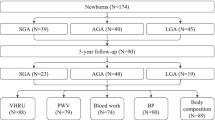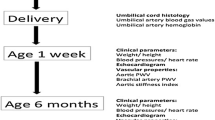Abstract
Objective
To investigate whether fetal growth restriction is associated with changes in cardiovascular risk factors later in life.
Design
A retrospective cohort study.
Settings
Tertiary-care hospital serving urban population from the Brazilian Northeast.
Participants/patients
172 adolescents aged 10–20 years were evaluated for the effects of fetal growth restriction on anthropometric measurements, blood pressure, lipids and fasting glucose and flow-mediated brachial artery dilatation.
Intervention
The adolescents’ birth weight and their gestational age at birth were used to identify fetal growth restriction according to the 10th percentile and divided between exposed (<10th percentile) and not exposed (≥10th percentile). The Student-t test or the Mann-Whitney test and chi-square were used. The significance level was considered to be 0.05.
Main Outcome Measure(s)
Current Anthropometric, metabolic and endothelial measures of subjects.
Results
The majority of the current anthropometric, metabolic and endothelial measures did not differ between groups. The unexposed group had a higher hip circumference (89.1 cm) and higher total cholesterol (196.4 mg/dL) than those exposed (85.4 cm, 136.9 mg/dL, respectively) (P=0.04).
Conclusions
In the sample studied, no association was found between fetal growth restriction and changes in cardiovascular risk factors in adolescents.
Similar content being viewed by others
References
Lee ACC, Katz J, Blencowe H, Cousens S, Kozuki N, Vogel JP, et al. National and regional estimates of term and preterm babies born small for gestational age in 138 lowincome and middle-income countries in 2010. Lancet Glob Health. 2013;1:e26–e36.
WHO ECoPS. Physical status: The use of and interpretation of anthropometry, Report of a WHO Expert Committee. 1995. Geneva: World Health Organization.
Black RE, Allen LH, Bhutta ZA, Caulfield LE, de Onis M, Ezzati M, et al. Maternal and child undernutrition: global and regional exposures and health consequences. Lancet. 2008;371:243–60.
Victora CG, Adair L, Fall C, Hallal PC, Martorell R, Richter L, et al. Maternal and child undernutrition: consequences for adult health and human capital. Lancet. 2008;371:340–57.
Barker DJP. Fetal origins of coronary heart disease. BMJ. 1995;311:171–4.
Barker DJP, Osmond C, Kajantie E, Eriksson JG. Growth and chronic disease: findings in the Helsinki Birth Cohort. Ann Hum Biol. 2009;36:445–58.
Cheung YF, Wong KY, Lam BCC, Tsoi NS. Relation of arterial stiffness with gestational age and birth weight. Arch Dis Child. 2004;89:217–21.
Jafar T, Qadri Z, Islam M, Hatcher J, Bhutta Z, Chaturvedi N. Rise in childhood obesity with persistently high rates of undernutrition among urban school-aged Indo-Asian children. Arch Dis Child. 2008;93:373–8.
Monteiro POA, Victora CG, Barros FC, Monteiro L. Birth size, early childhood growth, and adolescent obesity in a Brazilian birth cohort. Int J Obes. 2003;27:1274–82.
Dotsch J. Renal and extrarenal mechanisms of perinatal programming after intrauterine growth restriction. Hypertens Res. 2009;32:238–41.
Zanardo V, Fanelli T, Weiner G, Fanos V, Zaninotto M, Visentin S, et al. Intrauterine growth restriction is associated with persistent aortic wall thickening and glomerular proteinuria during infancy. Kidney Int. 2011;80:119–23.
Kapoor A, Dunn E, Kostaki A, Andrews MH, Matthews SG. Fetal programming of hypothalamo-pituitary-adrenal function: prenatal stress and glucocorticoids. J Physiol. 2006;572:31–44.
Leeson CPM, Whincup PH, Cook DG, Donald AE, Papacosta O, Lucas A, et al. Flow-mediated dilation in 9-to 11-year-old children: The influence of intrauterine and childhood factors. Circulation. 1997;96:2233–8.
Belfort MB, Rifas-Shiman SL, Rich-Edwards J, Kleinman KP, Gillman MW. Size at birth, infant growth, and blood pressure at three years of age. J Pediatr 2007;151:670–4.
Donker GA, Labarthe DR, Hamst RB, Selwyn BJ, Srinivasan SR, Wattigney W, et al. Low birth weight and serum lipid concentrations at age 7–11 years in a biracial sample. Am J Epidemiol. 1997;145:398–407.
Rodríguez-Soriano J, Aguirre M, Oliveros R, Vallo A. Long-term renal follow-up of extremely low birth weight infants. Pediatr Nephrol. 2005;20:579–84.
Fattal-Valevski A, Bassan H, Bernheim J, Redianu B, Leitner Y, Harel S. Blood pressure values in 8–12 year old children with a history of intrauterine growth retardation. Isr Med Assoc J. 2011;13:480–4.
Rossi P, Tauzin L, Marchand E, Boussuges A, Gaudart J, Frances Y. Respective roles of preterm birth and fetal growth restriction in blood pressure and arterial stiffness in adolescence. J Adolesc Health. 2011;48:520–2.
Vielwerth SE, Jensen RB, Larsen T, Holst KK, Mølgaard C, Greisen G, et al. The effect of birthweight upon insulin resistance and associated cardiovascular risk factors in adolescence is not explained by fetal growth velocity in the third trimester as measured by repeated ultrasound fetometry. Diabetologia. 2008 51:1483–92.
Victora CG, Barros FC, Horta BL, Martorell R. Short-term benefits of catch-up growth for small-for-gestational-age infants. Int J Epidemiol. 2001;30:1325–30.
Eriksson JG, Forsen T, Tuomilehto J, Osmond C, Barker DJ. Early growth and coronary heart disease in later life: longitudinal study. BMJ. 2001;322:949–53.
Pedreira CE, Pinto FA, Pereira SP, Costa ES. Birth weight patterns by gestational age in Brazil. An Acad Bras Cienc. 2011;83:619–25.
Onis M, Onyango AW, Borghi E, Siyam A, Nishida C, Siekmann J. Development of a WHO growth reference for school-aged children and adolescents. Bull World Health Organ. 2007;85:660–7.
Cunha Filho EV, Mohr C, Acauan Filho BJ, Gadonski G, Paula LG, Antonello ICF, et al. Flow-mediated dilatation in the differential diagnosis of preeclampsia syndrome. Arq Bras Cardiol. 2010;94:182–6.
Celermajer DS, Sorensen KE, Gooch VM, Spiegelhalter DJ, Miller OI, Sullivan ID, et al. Non-invasive detection of endothelial dysfunction in children and adults at risk of atherosclerosis. Lancet. 1992;340:1111–5.
Friedewald WT, Levy RI, Fredrickson DS. Estimation of the concentration of low-density lipoprotein cholesterol in plasma, without use of the preparative ultracentrifuge. Clin Chem. 1972;18:499–502.
Giuliano ICB, Caramelli B, Pellanda L, Duncan B, Mattos S, Fonseca FH. I diretriz de prevenção da aterosclerose na infância e na adolescência. Arq Bras Cardiol. 2005;85.
Lucas A, Fewtrell M, Cole T. Fetal origins of adult disease-the hypothesis revisited. BMJ. 1999;319:245.
Hemachandra AH, Howards PP, Furth SL, Klebanoff MA. Birth Weight, Postnatal growth, and risk for high blood pressure at 7 years of age: Results from the Collaborative Perinatal Project. Pediatrics. 2007;119:e1264–e70.
Adair LS, Martorell R, Stein AD, Hallal PC, Sachdev HS, Prabhakaran D, et al. Size at birth, weight gain in infancy and childhood, and adult blood pressure in 5 low-and middle-income-country cohorts: when does weight gain matter? Am J Clin Nutr. 2009;89:1383–92.
Author information
Authors and Affiliations
Corresponding author
Rights and permissions
About this article
Cite this article
Alves, P.d.J.d.S., Henriques, A.C.P.T., Silva, K.F. et al. The influence of fetal growth restriction on cardiovascular health among adolescents in Brazil: A retrospective cohort study . Indian Pediatr 52, 109–114 (2015). https://doi.org/10.1007/s13312-015-0582-5
Received:
Revised:
Accepted:
Published:
Issue Date:
DOI: https://doi.org/10.1007/s13312-015-0582-5




